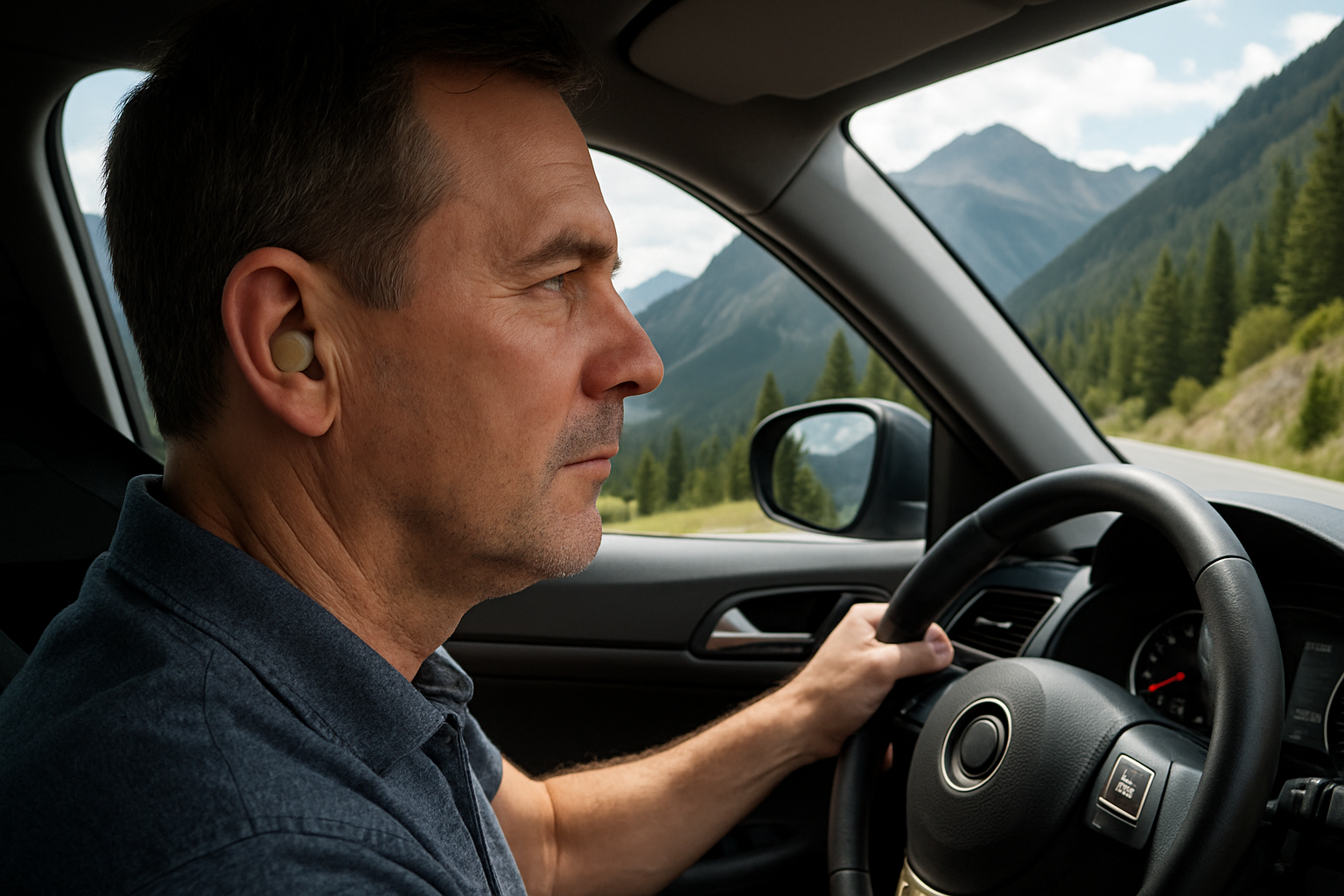Question: “Driving through the mountains, my hearing aids seemed to stop working. Did the high altitude cause it?”
The Quick Answer
No—altitude does not make modern hearing aids stop working. Their microphones, chips, and receivers aren’t affected by elevation changes. When sound suddenly seems muffled at high altitude, it’s almost always your ears reacting to pressure changes, not the devices.
What’s Really Happening: Middle Ear Pressure
Your middle ear is an air-filled space behind the eardrum. As you climb quickly, the outside air pressure drops. Normally, your Eustachian tubes (small passages to the back of the nose) open briefly so the pressure on both sides of the eardrum can match—this is the “pop.”
If the tubes don’t open, the eardrum can’t move freely, and everything sounds dull or “far away.” With hearing aids on, that pressure problem can feel like the aids lost power, even though they’re working normally.
Why Ears Don’t Always Pop
- Allergies, colds, or sinus infections swell the tissue around the tube openings.
- Reflux or nasal congestion can irritate the area.
- Rapid altitude changes (steep mountain roads, quick ascents while flying) give the ears less time to equalize.
If you also deal with earwax, muffled hearing can be worse. Learn the signs and safe fixes in our guide: Earwax Buildup: Symptoms, Causes & Safe Removal. And if you’re tempted to “clean deeper,” read How to Safely Clean Your Ears first.
If You Wear Custom Earmolds or ITE Hearing Aids
For users with custom earmolds or in-the-ear (ITE) style hearing aids, there’s another factor to consider: the vent. These tiny openings are designed to let air move between your ear canal and the outside world.
When the vent is clean and open, your ears can equalize pressure more easily, which makes popping your ears less difficult during altitude changes. If the vent is blocked by earwax or debris, it can trap air and make pressure symptoms worse. This can feel like your hearing aids “stopped working.”
Tip: Inspect and gently clean your vents regularly. Many custom earmolds come with a small cleaning tool (a brush or vent pick) provided by your audiologist. Keeping the vent clear not only helps with pressure equalization but also improves comfort and reduces the “plugged-up” sensation known as the occlusion effect.
What to Do in the Moment
- Swallow, yawn, or chew (gum or snacks). Gentle jaw movement helps the tubes open.
- Try the Toynbee maneuver: pinch your nose closed and swallow.
- Try a very gentle Valsalva: pinch your nose, close your mouth, and blow softly for 1–2 seconds. Stop if you feel pain—blowing too hard can injure the ear.
- Pause your ascent when possible. A short stop lets pressure catch up.
- Hydrate. Dry tissues don’t equalize as well.
If you’re congested, an over-the-counter saline nasal spray can help moisturize and clear the nose. Some travelers use short-term decongestants or steroid nasal sprays—ask your physician or pharmacist first to be sure they’re safe for you.
How to Prevent Problems Before Mountain Drives or Flights
- Manage allergies proactively during the season that bothers you most.
- Use saline before the trip to keep the nose and tube openings comfortable.
- Equalize early and often as you begin to ascend—small, frequent pops are easier than one big one.
- Consider pressure-regulating earplugs designed for flying; they slow the pressure change at the eardrum.
For a medical overview of Eustachian tube problems and airplane ear, see plain-language resources from AAO-HNS (ENT Health) and MedlinePlus.
Could It Ever Be the Hearing Aids?
Rarely, people notice sound changes during mountain travel due to condensation (moving from cold outside air to warm car cabins can create moisture). If you suspect moisture:
- Open the battery door (for zinc-air models) or place rechargeables in a drying jar/box at day’s end.
- Wipe microphones and charging contacts with a clean, dry cloth.
- Check for earwax on wax guards or domes—a quick change can restore clarity. See our wax care tips in this guide.
If the muffled sensation goes away when you yawn, swallow, or after descending, the issue was almost certainly middle ear pressure, not the devices.
When to See an Audiologist or ENT
- Muffled hearing lasts more than a day after you’re back at normal elevation.
- You have significant ear pain, fullness, or new tinnitus that doesn’t ease with equalization.
- You notice drainage or any sudden hearing change.
An audiologist can test your hearing and middle ear function and check your hearing aids. If the Eustachian tubes are the culprit, we’ll coordinate with an ENT when needed.
Bottom Line
Your hearing aids don’t stop working at high altitude. Sudden muffled sound in the mountains is almost always a temporary pressure-equalization issue in the middle ear. Help your ears pop gently, keep earmold vents clear, manage congestion, and check for moisture or wax. If symptoms linger, schedule a visit—we’re here to help.

